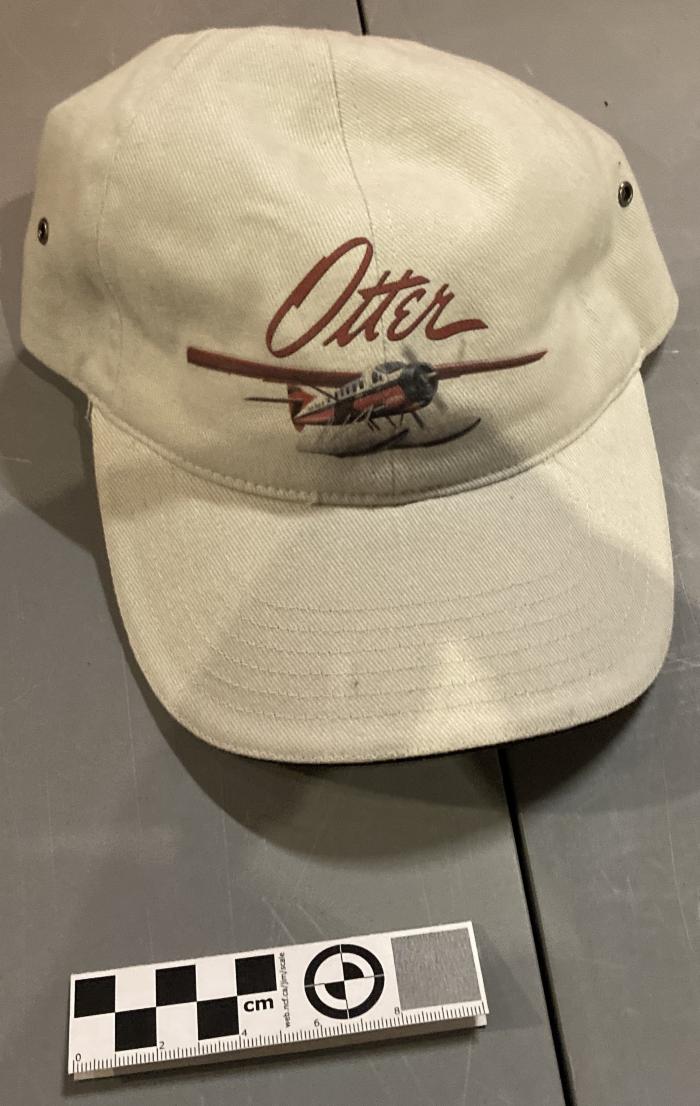Baseball Cap
Object
2024.4.24
Creme-white baseball cap with a logo reading "OTTER" over a floatplane across the front
Conceived as a slightly-larger successor to the De Havilland DHC-2 Beaver, the Otter is a well-seasoned bush-plane with immense popularity among remote operators. Fittable with wheels, floats, or skis, the Otter boasts a short distance required for take-off and landing, as well as a crew-complement of 2 with a passenger complement ranging 9-11. The Otter’s characteristics are as such:
Length: 41 ft 10 in (12.75 m)
Wingspan: 58 ft 0 in (17.68 m)
Height: 12 ft 7 in (3.84 m)
seaplane 15 ft 0 in (5 m)
Empty weight: 4,108 lb (1,863 kg)
seaplane 4,620 lb (2,096 kg)
fixed skis 4,361 lb (1,978 kg)
Gross weight: 8,000 lb (3,629 kg)
Fuel capacity: Total fuel 178 imp gal (214 US gal; 809 L)
Engine: 1 × Pratt & Whitney R-1340-S1H1-G Wasp 9-cylinder air-cooled radial piston engine, 600 hp (450 kW) or -S3H1-G (lower supercharger gearing)
Cruise speed: 138 mph (222 km/h) at 5,000 ft (1,524 m)
Range: 960 mi (1,540 km, 830 nmi) full internal fuel at 5,000 ft (1,524 m)
seaplane 863 mi (750 nmi; 1,389 km) full internal fuel at 5,000 ft (1,524 m)
Highest Altitude: 18,800 ft (5,700 m) S1H1-G engine
17,400 ft (5,304 m) S3H1-G engine
Take-off distance to 50 ft (15 m): 1,310 ft (399 m)
seaplane 1,980 ft (604 m)
Landing distance from 50 ft (15 m): 975 ft (297 m)
seaplane 1,510 ft (460 m)
Between 1952 and 1967, 466 Otters were manufactured, finding later use among civilian as well as military aviators in Canada, Australia, Bangladesh, Cambodia, Chile, Costa Rica, Ethiopia, Ghana, India, Indonesia, Myanmar, New Zealand, Nicaragua, Nigeria, Norway, Panama, Paraguay, Philippines, Tanzania, United Kingdom, and the United States. With such a wide dispersal over so many places, it is no surprise that some people made a hat commemorating the rugged Otter! Between the plane’s good design and many mechanics’ efforts, the Otter still flies from airfields, created or improvised, in the present day
Length: 41 ft 10 in (12.75 m)
Wingspan: 58 ft 0 in (17.68 m)
Height: 12 ft 7 in (3.84 m)
seaplane 15 ft 0 in (5 m)
Empty weight: 4,108 lb (1,863 kg)
seaplane 4,620 lb (2,096 kg)
fixed skis 4,361 lb (1,978 kg)
Gross weight: 8,000 lb (3,629 kg)
Fuel capacity: Total fuel 178 imp gal (214 US gal; 809 L)
Engine: 1 × Pratt & Whitney R-1340-S1H1-G Wasp 9-cylinder air-cooled radial piston engine, 600 hp (450 kW) or -S3H1-G (lower supercharger gearing)
Cruise speed: 138 mph (222 km/h) at 5,000 ft (1,524 m)
Range: 960 mi (1,540 km, 830 nmi) full internal fuel at 5,000 ft (1,524 m)
seaplane 863 mi (750 nmi; 1,389 km) full internal fuel at 5,000 ft (1,524 m)
Highest Altitude: 18,800 ft (5,700 m) S1H1-G engine
17,400 ft (5,304 m) S3H1-G engine
Take-off distance to 50 ft (15 m): 1,310 ft (399 m)
seaplane 1,980 ft (604 m)
Landing distance from 50 ft (15 m): 975 ft (297 m)
seaplane 1,510 ft (460 m)
Between 1952 and 1967, 466 Otters were manufactured, finding later use among civilian as well as military aviators in Canada, Australia, Bangladesh, Cambodia, Chile, Costa Rica, Ethiopia, Ghana, India, Indonesia, Myanmar, New Zealand, Nicaragua, Nigeria, Norway, Panama, Paraguay, Philippines, Tanzania, United Kingdom, and the United States. With such a wide dispersal over so many places, it is no surprise that some people made a hat commemorating the rugged Otter! Between the plane’s good design and many mechanics’ efforts, the Otter still flies from airfields, created or improvised, in the present day
